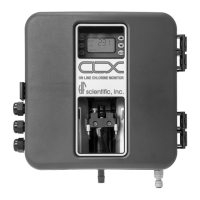CLX (4/18) Page 17
REV 6.0
7.4 Configuring the Alarms
Two relays are provided that are designed to operate as two independent programmable
alarms or as a system problem alarm. Please note that changes to alarms will not be
recognized until the start of the next cycle. Two settings must be selected to fully program
each alarm:
1. The alarm function (HI, LO, OFF or Error)
2. The alarm set point (level at which the alarm activates)
These items are described below:
Alarm Function: The alarms can either be turned OFF or selected to operate in one of
three different manners:
1. HI alarm: the relay changes state when the measured chlorine level is higher than the
programmed alarm level (set point).
2. LO alarm: the relay changes state when the measured chlorine level is lower than the
programmed alarm level (set point).
3. Error alarm: If there is a system fault or problem the alarm will change states.
Alarm Set Point: The level at which an alarm activates is called the alarm set point. On
the instrument, the alarm set point is designated as “S/P”. The set point is adjustable to
any valid chlorine level over the range of the instrument in steps of 0.01 mg/L. This
setting is not available if the Error function is chosen
7.4.1 Alarm 1
Alarm 1 Function: The ALM1 is displayed and the display indicates the current
function of alarm 1 (HI, LO, OFF, or Error). Use the or buttons to cycle
through and select the desired function. Press the button to accept the selection.
If the alarm was turned OFF, a prompt will appear to set up alarm 2, see section
7.4.2).
Alarm 1 Set Point: This prompt is used to select the set point for this alarm; this
is indicated by “S/P” shown on the lower row of the display. Select the desired
alarm level by using the and buttons. Once the desired set point has been
set, press the button to accept it.
7.4.2 Alarm 2
Repeat the procedure listed in section 7.4.1 to set up the parameters for alarm 2. If
a selection was made to turn the alarm OFF, the next selection for the speed of
response RESP is shown.
Due to the cyclic nature of the CLX, relay chatter is not an issue. There is no need for
alarm delays or hysteresis.

